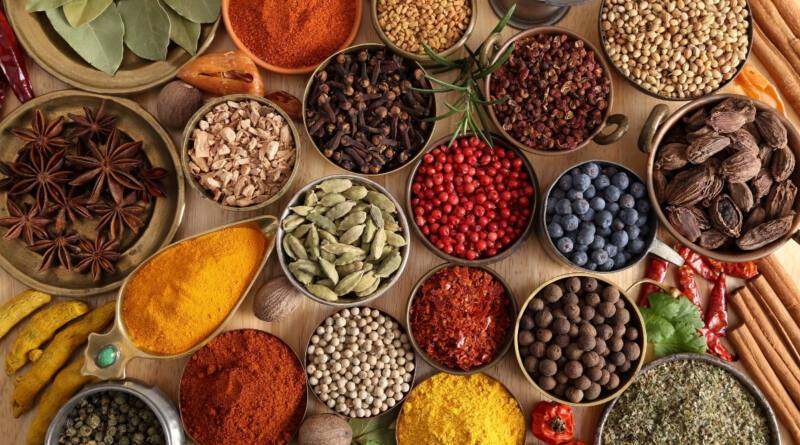Better Health: Indian Spices You Need To Know
Discover the Health Benefits of 4 Traditional Indian Spices: Haldi, Ajwain, and More
Indian cuisine is famous for its diverse spice combinations, which not only add unique flavours to each dish but also offer numerous health benefits recognised by traditional Indian medicine. Indian cuisine is a delightful fusion of flavours, with spices playing a crucial role in creating its distinct taste, enticing aroma, and irresistible appeal. From the fiery kick of chilli peppers to the fragrant allure of cinnamon, these spices work their magic to elevate every dish.
India has a rich history of incorporating a diverse range of spices into its culinary creations.
Today’s modern world often overlooks the medicinal benefits of taste, a value Ayurveda and holistic living have valued for centuries. We share insights into the benefits that these spices bring to our overall well-being.
Salt: A vital ingredient in cooking and a key player in food preservation, salt (primarily sodium chloride) is essential for life. It is particularly important for preserving evergreen food items found in every Indian household, such as achars, also known as pickles. It really lets the flavours of the other ingredients take centre stage. When it comes to our health, salt plays a crucial role in maintaining our blood pressure and blood volume, as well as aiding in nerve conduction. Furthermore, adding iodine to salt facilitates smooth thyroid gland function.
Consuming too much salt, on the other hand, can lead to high blood pressure and an increased risk of heart disease.
We create Khada Masala, an aromatic Indian spice mixture, by lightly toasting and grinding essential ingredients such as green and black cardamom, cinnamon, cloves, star anise, nutmeg, black pepper, cumin, and coriander seeds, among others. Roasting these spices releases their aromatic oils, which then become ground or added to dishes.
Spices in the Khada Masala offer a range of health benefits. Cinnamon, for example, is known for its anti-inflammatory properties and its ability to regulate blood sugar levels. It can also improve insulin sensitivity, which is particularly beneficial for managing PCOS-like symptoms. Clove, on the other hand, is believed to have anti-cancer properties and is great for maintaining oral hygiene.
Lastly, nutmeg is known for its ability to promote restful sleep.
Turmeric (Curcumin): Turmeric is known for its active compound curcumin, which has gained popularity for its anti-inflammatory, antioxidant, and antibacterial properties. We often use it in ‘turmeric lattes’ as well as our traditional cough and cold remedy, ‘haldi doodh’. Every Indian household regularly uses this common ingredient in their cooking. It not only adds flavour to dishes but also provides various health benefits.
Curcumin is known for its anti-inflammatory properties, which may help lower the risk of heart disease. Additionally, extensive research has explored its potential for preventing and treating Alzheimer’s disease and cancer. Interestingly, curcumin has a rather low bioavailability. But here’s a tip: consuming it with black pepper, which contains piperine, can greatly improve its absorption.
Ajwain is known for its ability to improve digestion, thanks to a powerful phenolic compound called thymol that helps boost digestive enzymes. When boiled in water to make herbal tea, it can enhance digestion, alleviate acidity, and greatly reduce bloating, which is particularly beneficial after pregnancy.
INDIAN SPICES For You
The skillful use of a broad range of Indian spices and aromatics is a crucial component of traditional Indian recipes that distinguish them from other cuisines. Cardamom, cumin, clove, turmeric, coriander, cinnamon, and fenugreek are the seven essential spices in Indian cuisine, while many more are frequently used in the wide variety of traditional Indian recipes.
Different Indian cuisine varieties use herbs and spices in distinctive ways that set them apart from other parts of the nation. While some spices, like black pepper, nutmeg, garlic, and ginger, are commonly known in the West, Indian food gets its unique flavour from the carefully blended blends of local spices.
Typical Indian spices include:
- Turmeric: Known for its earthy undertone and warm, spicy aromas, this spice has a beautiful golden hue.
- Ginger: earthy citrus undertones with a warm, spicy, and sweet taste.
- Garlic: a powerful scent with notes of sulphur and a pungent spiciness similar to onions. Occasionally chopped or combined into a paste. Garlic cloves can also be cooked over a fire.
- Cumin: a fragrant, earthy, and toasty relative of parsley that can be used whole or crushed. Extensively used in spice blends in Indian cuisine.
- Cardamom: Often used in Indian cuisine, both black and green cardamom have a powerful scent. Black cardamom smells smokey and has a mint-like cooling effect.
- Saffron: red filaments from the Crocus sativus flower, accompanied with grassy or hay-like notes and a hint of metallic honey. Gives off a vibrant yellow colour.
- Coriander: adds a nutty, citrusy, or acidic flavour that is occasionally thought to taste like dish soap. Many famous Indian cuisines frequently include fresh coriander as a garnish. Known by another name, cilantro is utilised in Indian cooking, both the fresh leaves and the dried seeds.
- Garam Masala: a popular ground spice mixture used in Indian cuisines, with regional variations in the ingredients. Includes common Indian spices such as coriander, cumin, cardamom, cloves, black pepper, cinnamon, and nutmeg. It gives traditional Indian meals a hint of sweetness, warmth, and flowery undertones.
- Asafoetida: from the tap root of perennial herbs in the celery family, a strong, sticky substance released. Improves the savoury flavours of vegetarian meals and aids in achieving a harmonious flavour balance in well-known Indian recipes like Rogan josh.
- Fenugreek: this versatile herb, spice, and vegetable has a strong taste reminiscent of maple syrup and is used in many Indian dishes.
- Tej Patta: sometimes referred to as Indian bay leaves, they have a potent perfume that is similar to clove and cinnamon.
- Fennel: with a strong anise scent akin to licorice, it is utilised in a variety of Indian dishes, from Kashmiri to Bengali. Used as a breath refresher occasionally.
- Star anise: this spice has a strong anise aroma and is used to make traditional Indian dishes like biryani and masala chai.
- Mace/nutmeg: strong flavour and warm, slightly sweet scent. Similar in flavour, but with a more subtle undertone, is mace, which is derived from the reddish covering of nutmeg seeds.
- Clove: a very fragrant member of the evergreen family that is frequently used to flavour curries, marinades, and sweets. It is commonly combined with other warm spices like cinnamon, nutmeg, and star anise.
- Carrom, sometimes called b, is a very fragrant herb with a perfume akin to thyme, as well as earthy, minty overtones and bitter notes reminiscent of oregano and anise.
- Mustard Seed: this aromatic, strong-flavoured spice is frequently added to Indian pickles and spicy seafood recipes.
- Indian red chilies: these can be added to curries, pickles, and chutneys to increase their heat content. They can be used whole, dried, or ground into a powder
- Curry Leaves: commonly used in South and West Indian cuisine, these leaves have a strong, bitter taste akin to asafoetida, with hints of lemongrass and citrus leaves.
- Mint: a fragrant plant with a cooling effect that is utilised in Indian cuisine and beverages.
Now try and grab some of these spices and add them to your kitchen collections to spice up your health!




